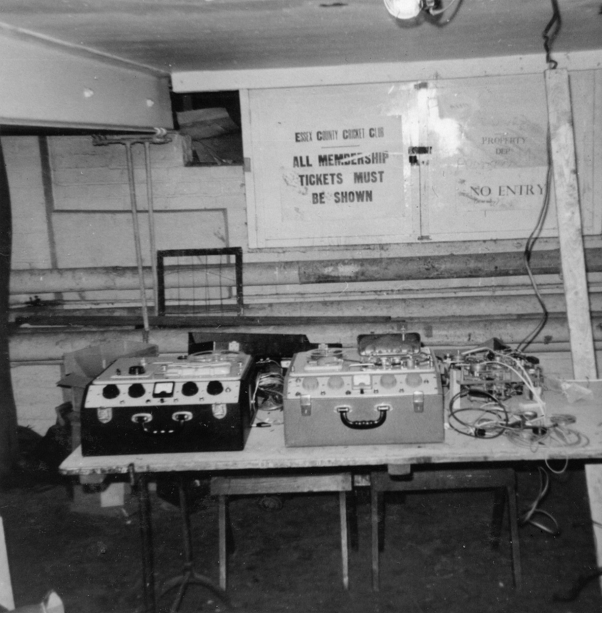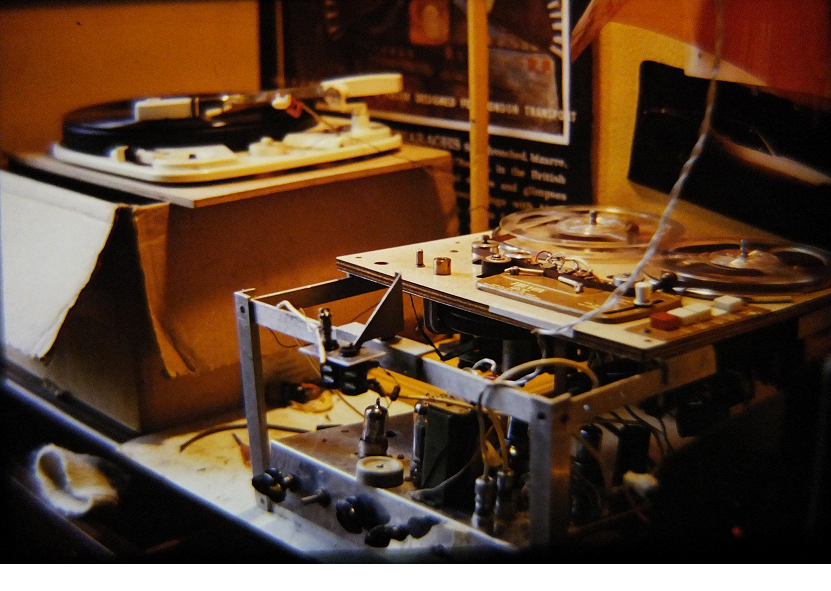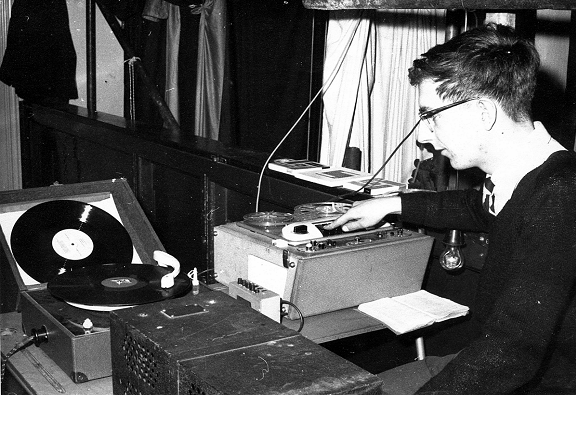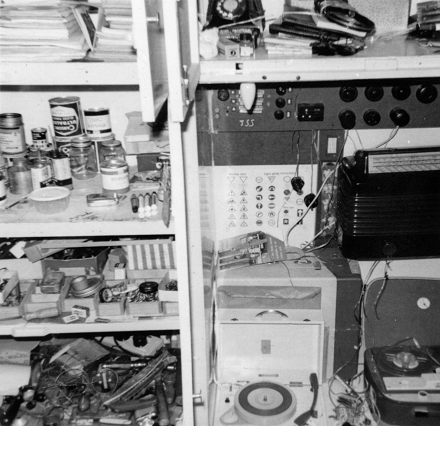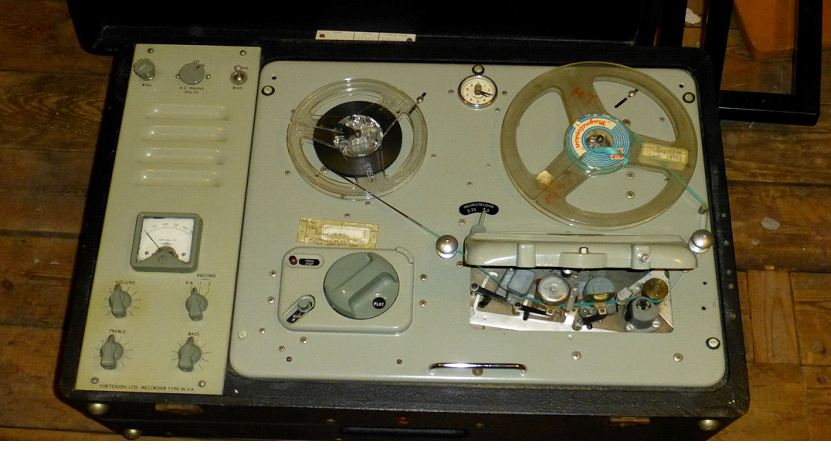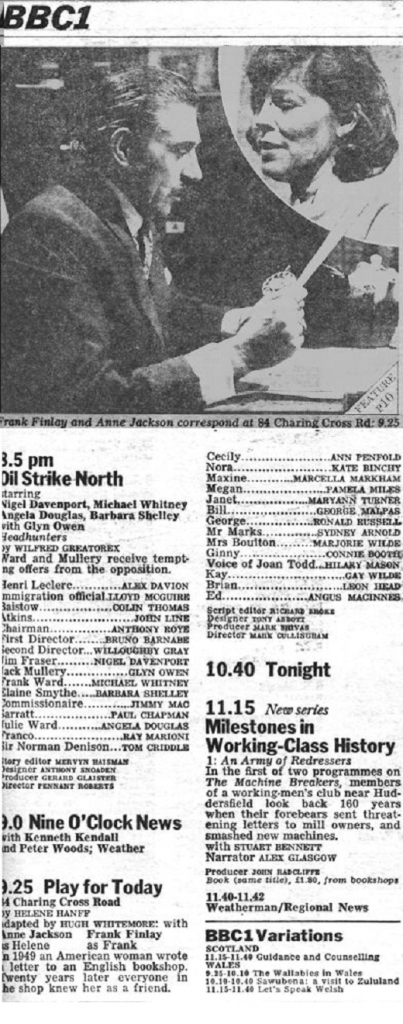Mike Jordan
Didn’t we all have Ferrographs, even at school?
segue from BBC Recording Tape
(Click on the picture below to see larger version:
use your Browser’s BACK button to return to this page)
All the stage sound Fx were played in on these (except the ones that came off discs we bought from somewhere in Soho).
And later, on the one in BH Switching Centre, I recorded all episodes of “I’m sorry I’ll read that again” off ring main (and still have).
My copy of Paul Simon singing at school was recorded on my Elizabethan recorder.
Dave Wagner
Is that a Ferrograph I see before me?
I used to have to carry these extremely heavy machines (at 14 years old) between classes for the playback of recorded schools programmes.
We always carried them with the back to the stomach because that was where the heavy bits were!
Nick Ware
We all had Ferrographs. Mine was a 5AN. Just like the grey one in the picture above.
The unusual and slightly worrying thing about the Ferrograph was that it had a rubber-tyred capstan and a solid pinch wheel. That meant that speed, and hence pitch, was dependant on the pinchwheel pressure being just right. Apply more pressure and the playback pitch went fractionally sharp. People who knew Harold Dines, who ran the Ealing transfer suite, doubtless knew that he had a very sophisticated lathe at home. Harold made me a solid capstan sleeve, and somehow made a rubber tyre for the turned-down solid pinchwheel. Marked improvement for musician friends of mine who suffered ‘perfect pitch’.
Dave Mundy
My first tape recorder was a Philips EL3538 half-track mono, three speed, valve machine (which I still have!). I bought it in the late 1950s on Hire Purchase’! My dream machine in Nottingham Tape Recorders, where I bought it, was the Tandberg 72, small, and three heads, but no speakers. Also in the shop was the much larger Reflectograph, but they were both far too expensive for a school-leaver.
The Philips kept me going until the 1980s! In TVC, the production offices used Tandberg 15 3-speed mono machines for office listening, same size as the stereo 72 but obviously much more limited, although it did have a decent built-in speaker.
When I joined OBs and went onto the single-camera Sports Unit, whenever we did a shoot in Nottingham we always visited ‘Aladdin’s Cave’ i.e. Anchor Surplus! On one visit I spotted a Tandberg 15 ex-military language laboratory machine which I bought for £7.50, as the capstan was seized. Having unwound the tape from it and soaked the bearings overnight it worked perfectly! Next, my camera colleague on the Sports Unit used to help out at his local church and they wanted to get rid of their Tandberg 1/4 track machine. I helped them out! Next, I discovered a service engineer in Doncaster who restored Tandberg machines and took it up there. I managed to swap my 1/4 track m/c for a 1/2 track so that I could play my 2 track stereo tapes copied from the Evesham stereo demo tapes! It is a 3300X cross-field head machine, flat to 18K (they say). Anyway, it’s as near perfection as I need.
Tony Crake
Well here is something not very perfect, but it gave me something to "twiddle with"…
(Click on the picture below to see larger version:
use your Browser’s BACK button to return to this page)
This strange looking contraption is a TRUVOX. I bought it from John Milner when I was on Crew 3 (in the TOTP in Studio G days)
It had a very large Capstan motor with a big flywheel. The large button was a tape lifter arm which pulled the tape off the heads for spooling.. It went at a fantastic speed and had DC braking on the two spooling motors ( the Red Button).
But the oddest thing was the tape went from Right to Left, with the heads upside down (!) so it was "compatible" with conventional tapes. The Valves were for a Mullard type C Replay/Record Unit. It was great fun.
I’m not sure whose the Record Deck was, but the box underneath it was full of the VT 1/4" tape rendered down from 2" Quad Tape on the infamous Razor Blade Jig!
John Howell
The turntable looks like a Garrard 4HF.
No we didn’t all have a Ferrograph at school. The school had a single speed Grundig TK20, the best thing about it was the large diaphragm condenser mic. I had a Lasky’s kit of parts (24guineas) involving a Collaro Studio three speed three motor deck, (pictured) and a much modified Mullard Type ‘B’ preamp.
(Click on the picture below to see larger version:
use your Browser’s BACK button to return to this page)
The power amp in the foreground was a sort of Mullard 5-10 with octal based 6V6s in push-pull for the output. The ‘disc channel’ was a Collaro record player with a Studio ‘T’ cartridge which shovelled out many Volts of distorted audio.
The input selector was a Channel switcher from a WW2 aircraft.
I could make that tape deck start and stop silently unlike the Ferrograph I encountered at a local Theatre Guild production.
Dave Mundy
I remember being awfully impressed with John Howell’s article in “Hi-Fi News” on how to convert the Collaro deck to vari-speed spooling! I was given a Collaro studio deck by a VO at TVC with every intention of following the article. I also researched getting the recommended Miniflux stereo heads and building pre-amps for them. I still have the deck!
I did actually buy a stereo Miniflux head and attached it to the Philips machine I mentioned earlier, and together with a home-made stereo pre-amp fed it into my two Mullard 5-10s feeding my home-made bass reflex speakers (with Goodman’s Axiom 10 + 5K20XL horn tweeters, later superseded by T27s). Stereo at last – whoopee!.
Mike Jordan
My bedroom cupboard around Sept 1965:
(Click on the picture below to see larger version:
use your Browser’s BACK button to return to this page)
I think I made this recorder from bits – probably also Henrys Radio. Nice little turntable and note the very highly specified dis board above. The little home made boxes for screws still in use!
Dave Mundy
Does anyone remember the annual Audio Fairs held at the Russell Hotel? Lots of bedrooms made into demo. studios for the best British hi-fi equipment (there was no other in those days, apart from an American Fisher amp. and a single Japanese one!). My dream combination was a Garrard 301+ SME 12"arm + Ortofon moving coil cartridge + complete Quad set-up + Spendor LS (I didn’t think ‘er indoors would tolerate the Quad electrostatic LSs!).
My mate Dave Ball, from TVC, left and went to Rolls-Royce labs in Derby and had a bungalow built in Gedling near Nottingham. At one end of his large lounge was a ceiling to floor net curtain behind which was an amazing array of loudspeakers fed by his 301, SME, Shure V15, and Radford 22 set-up. The speakers included IMF transmission line LS, Lowther Acoustas, and GEC metal cone LS. The results were terrific. He worked in the noise measuring lab at RR where they used specially tweaked Nagras flat to 30 KHz. and B&K mics. He borrowed one to record the well-known ‘Flying Scotsman’ coming into Grantham station and the floor of his bungalow shook and you could smell the steam etc.
Dave Beer
Yes I remember the annual Audio Fairs, I used to go there for quite a few years often with our very own Bernie Newnham! I first saw and eventually bought a semi pro reel to reel recorder made by TRD (Tape Recorder Developments, an offshoot of a company that made mixing desks). Unfortunately, their capstan/pinch wheel engineering wasn’t good and it suffered from wow and flutter. Eventually, after trying to fix it, they bought the machine back off me and I invested in a Revox which I still have. Also in the loft is my classic pair of Quad electrostatics which I bought second hand back in the 1960s with my first BBC wages! ‘Er indoors here surprised me the other day when she said I might be allowed to install them downstairs if I’m good – hope they still work, must power them up again.
Pat Heigham
I remember being mightily impressed with a demo room playing jazz band recordings.
Investigation revealed that the noise was coming off an Ampex deck with the tape at 30ips into the very large Tannoy speakers behind a gauze curtain (Autographs?) Don’t know what the amps were (Ampex again?)
I invested in a pair of Quad Electrostatics but was rather disappointed, as I expected an exciting ‘electric’ sound. Maybe I wanted bum and tits (sorry – boom and tizz!) The quality of the Electrostatics eventually came home when listening to a radio play in stereo, and a character said something on one channel only, and I jumped, as I thought there was someone in the room! Eventually they were sold to an outfit in Bristol which dealt with vintage kit, and for a good price.
I bought BNS speakers off Nick Ware, which still give hours of delight, and they are so accurately matched. That reminds me – on “Music in Time”, recording the Czech Philharmonic in the Dvorak Hall in Prague. The guy in charge was awfully keen for us to see his control room, which we rather put off, thinking it wouldn’t be much cop, until we finished the session, to be ‘eyes opened’ in astonishment when confronted with a Neve desk, Ampex decks and Lockwood monitors! (It turned out that they supplied masters for Supraphon, which were handled by EMI in the UK. As there was a problem in paying them in sterling, remuneration was provided in the form of the latest equipment!)
Memories, memories – Memorex!
John Nottage
I still have my same old hi-fi set-up – Quad 300 stack and Spendor BC1s. The only modern addition is my Cocktail Audio X10 hard disc machine.
Barry Bonner
Whilst we’re playing "Bottom trumps" on old kit here here’s my trusty Vortexion WVA. It dates from 1954. I used it many times for editing BBC stuff at home thus saving travel. In particular I used it for editing voice-overs for "84 Charing Cross Road" when I was a Gram Op. Frank Finlay and Anne Jackson (Mrs. Eli Wallach) were the stars. (The later film version wasn’t as good!) Chick Antony mixed the show. I had 96 tape cues, a lot of which involved following Anne’s typing. Phew! The machine is still in full working order!
(Click on the pictures below to see larger versions:
use your Browser’s BACK button to return to this page)


